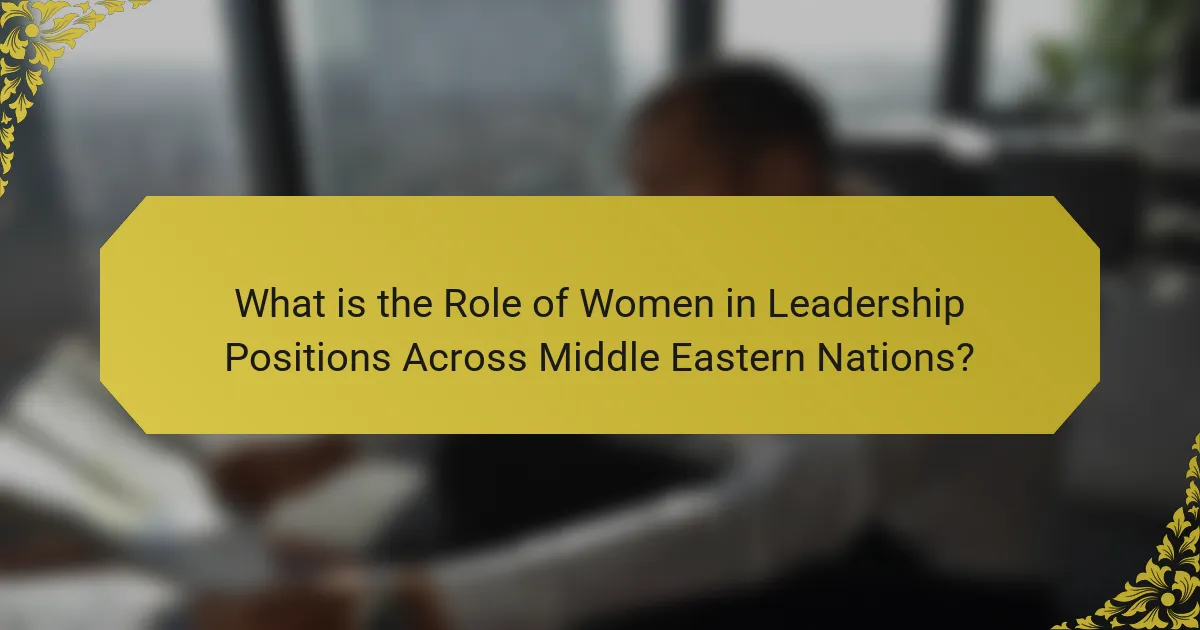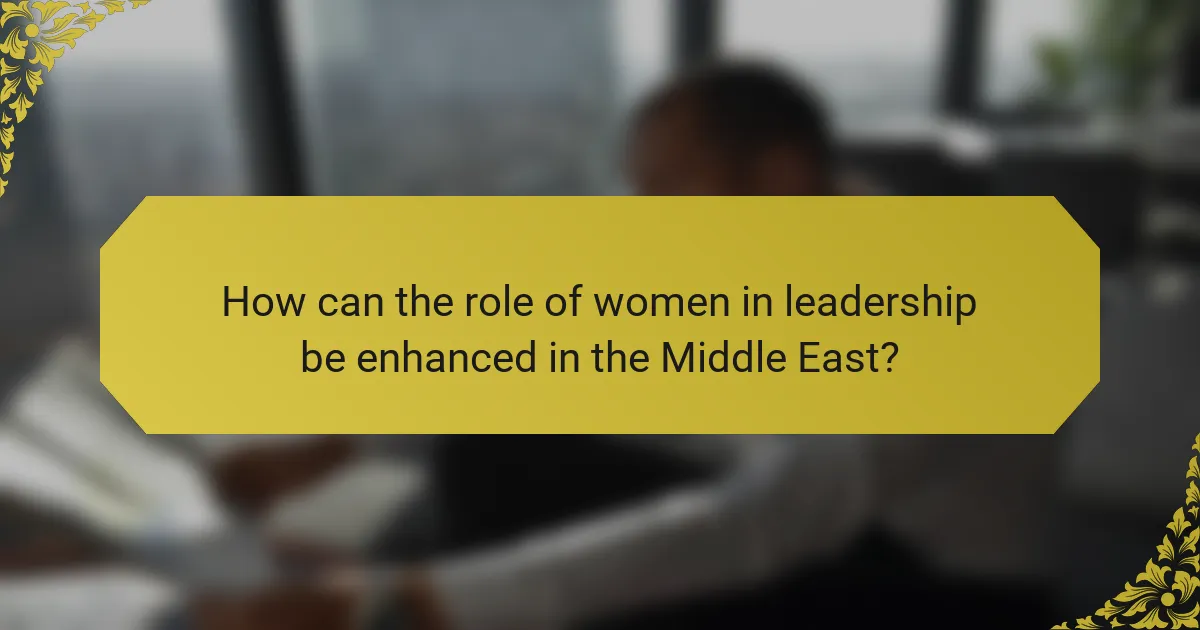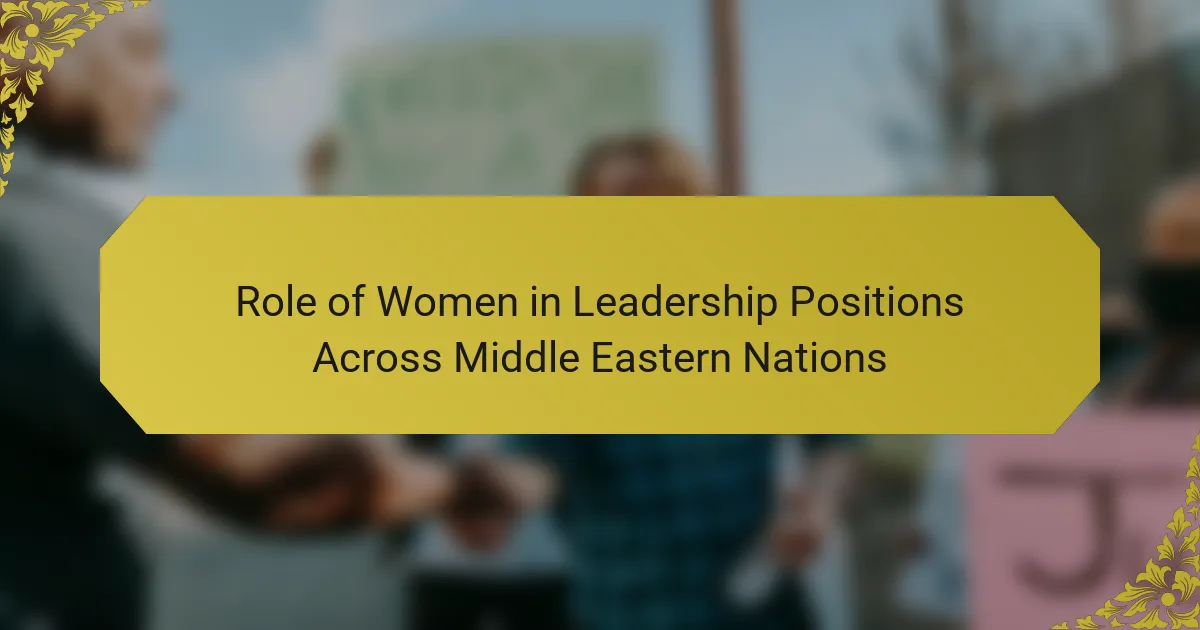
What is the Role of Women in Leadership Positions Across Middle Eastern Nations?
Women in leadership positions across Middle Eastern nations play a vital role in driving social and economic progress. Their participation has been increasing in various sectors, including politics, business, and civil society. For instance, countries like the United Arab Emirates and Saudi Arabia have made significant strides in promoting women to leadership roles. The UAE appointed its first female Minister of State for Youth Affairs in 2016, highlighting a commitment to gender equality. In Saudi Arabia, Vision 2030 aims to increase women’s participation in the workforce to 30%. Research by the World Economic Forum indicates that greater female representation in leadership correlates with improved organizational performance. Furthermore, women in leadership positions often advocate for policies that support women’s rights and empowerment. This shift is transforming traditional gender roles and challenging societal norms across the region.
Why is the participation of women in leadership important in the Middle East?
The participation of women in leadership is crucial in the Middle East for several reasons. It promotes gender equality and empowers half of the population. Women’s leadership has been linked to improved decision-making and governance. Studies show that diverse leadership teams enhance organizational performance. For example, a McKinsey report found that companies with more women in leadership roles are 21% more likely to outperform their counterparts. Furthermore, women’s participation can drive economic growth. The World Bank estimates that closing gender gaps in labor force participation could boost GDP significantly. Lastly, having women in leadership positions can inspire future generations of girls, fostering a culture of ambition and achievement.
What historical factors have influenced women’s leadership roles in the region?
Historical factors influencing women’s leadership roles in the Middle East include cultural traditions, colonial histories, and socio-political movements. Cultural traditions often dictate gender roles, limiting women’s participation in leadership. Colonial histories introduced new governance structures, sometimes empowering women through education and political involvement. Socio-political movements, such as the women’s rights movements in the 20th century, have also played a crucial role. For instance, the Arab Spring in 2011 saw increased visibility of women in public leadership roles. Additionally, legal reforms in various countries have aimed to enhance women’s rights and representation. These factors collectively shape the landscape of women’s leadership in the region.
How do cultural perceptions impact women’s leadership opportunities?
Cultural perceptions significantly impact women’s leadership opportunities by shaping societal attitudes and expectations. In many Middle Eastern nations, traditional views often prioritize male leadership. These perceptions can lead to gender biases in hiring and promotion practices. For example, women may be overlooked for leadership roles due to stereotypes about their capabilities. Studies show that organizations in cultures with strong gender roles often have fewer women in management positions. Additionally, cultural norms may discourage women from pursuing leadership roles altogether. This can result in a lack of female role models, further perpetuating the cycle of underrepresentation.
What are the current statistics on women’s leadership in Middle Eastern countries?
As of 2023, women’s leadership in Middle Eastern countries remains significantly underrepresented. According to the World Economic Forum, women hold only 13% of leadership roles in the region. This statistic highlights the persistent gender gap in executive positions. In countries like Saudi Arabia, women represent 20% of decision-making roles. In contrast, the United Arab Emirates reports a higher percentage, with women occupying 27% of leadership positions. However, these figures vary widely across different countries. Research from the McKinsey Global Institute indicates that increasing women’s participation in leadership could add $1 trillion to the region’s economy by 2025. These statistics illustrate both the challenges and the potential for women’s leadership in the Middle East.
Which countries have the highest representation of women in leadership roles?
Rwanda, Cuba, and New Zealand have the highest representation of women in leadership roles. Rwanda leads globally, with women holding 61% of parliamentary seats. Cuba follows with approximately 53% of its legislative positions occupied by women. New Zealand has around 50% representation in its parliament. Other countries with notable representation include Mexico and the United Arab Emirates, with women holding 50% and 27% of leadership roles, respectively. These statistics highlight significant progress in gender equality in leadership across these nations.
How do these statistics compare to global averages?
Women’s representation in leadership positions in Middle Eastern nations is significantly lower than global averages. For instance, as of 2023, women hold approximately 15% of leadership roles in the Middle East. In contrast, the global average for women’s representation in leadership positions is around 30%. This disparity highlights the challenges women face in attaining leadership roles in this region. Various studies, including the World Economic Forum’s Global Gender Gap Report, emphasize the need for policies that promote gender equality in leadership. The report indicates that while some progress is being made, the gap remains substantial when compared to global standards.

What challenges do women face in attaining leadership positions?
Women face several challenges in attaining leadership positions. These challenges include cultural biases that favor male leadership. Societal norms often dictate traditional gender roles, limiting women’s opportunities. Lack of access to professional networks also hinders women’s advancement. Research shows that only 7% of leadership roles in the Middle East are held by women. Furthermore, women often encounter discrimination in hiring and promotion processes. Balancing work and family responsibilities presents an additional obstacle. According to the World Economic Forum, gender parity in leadership roles is still far from being achieved. These factors collectively impede women’s progress in leadership across Middle Eastern nations.
What barriers hinder women’s advancement in leadership roles?
Barriers hindering women’s advancement in leadership roles include cultural norms, lack of access to networks, and gender bias. Cultural norms often dictate traditional gender roles, limiting women’s opportunities. Lack of access to professional networks restricts mentorship and sponsorship for women. Gender bias in hiring and promotion processes further disadvantages women. Research indicates that women hold only 14% of executive positions globally, highlighting systemic issues. Additionally, a report from McKinsey & Company shows that women are less likely to be promoted compared to their male counterparts. These factors collectively create significant obstacles for women seeking leadership roles.
How do legal and political frameworks affect women’s leadership opportunities?
Legal and political frameworks significantly influence women’s leadership opportunities. These frameworks determine the rights and privileges women hold in society. For example, laws regarding gender equality can enhance women’s access to leadership roles. In contrast, restrictive laws can hinder their participation. Political will is also crucial; supportive governments can implement policies that promote women’s leadership. Conversely, regimes lacking commitment may perpetuate barriers. In many Middle Eastern nations, legal reforms have led to increased female representation in politics. According to the World Economic Forum, countries with gender-inclusive policies report higher numbers of women in leadership positions. Thus, legal and political frameworks are vital in shaping women’s opportunities for leadership.
What societal norms contribute to these challenges?
Societal norms that contribute to challenges for women in leadership positions in Middle Eastern nations include traditional gender roles. These roles often prioritize men as leaders and decision-makers. In many cultures, women are expected to focus on family and domestic duties. This expectation limits their opportunities for professional advancement. Additionally, societal perceptions of women’s capabilities can undermine their confidence and ambition. Resistance to change from established patriarchal structures further exacerbates these challenges. Research shows that countries with strong gender stereotypes see lower female representation in leadership. For example, a study by the World Economic Forum indicates that gender parity in leadership roles is significantly affected by cultural attitudes.
What initiatives are being implemented to support women in leadership?
Various initiatives are being implemented to support women in leadership. Governments in Middle Eastern nations are promoting gender equality through policies and programs. For instance, Saudi Arabia has introduced Vision 2030, which aims to increase women’s participation in the workforce. The UAE has established the Gender Balance Council to enhance women’s roles in leadership. Additionally, mentorship programs are being developed to connect aspiring women leaders with established professionals. Research indicates that organizations with diverse leadership perform better, reinforcing these initiatives’ importance. Statistics show that countries with supportive policies see increased female representation in leadership roles.
Which organizations are leading the charge for women’s leadership empowerment?
Organizations leading the charge for women’s leadership empowerment include UN Women, the World Economic Forum, and the International Women’s Forum. UN Women focuses on gender equality and women’s empowerment globally. The World Economic Forum promotes women’s leadership through initiatives like the Gender Parity Task Force. The International Women’s Forum connects women leaders across various sectors to foster collaboration and mentorship. These organizations provide resources, advocacy, and platforms to support women’s advancement in leadership roles.
What role does education play in overcoming leadership barriers for women?
Education plays a crucial role in overcoming leadership barriers for women. It equips women with essential skills and knowledge necessary for leadership roles. Access to education increases women’s confidence and self-efficacy. Studies show that educated women are more likely to pursue leadership positions. For instance, research from the World Economic Forum indicates that countries with higher female education levels have more women in leadership roles. Education also fosters networking opportunities and mentorship, which are vital for career advancement. Furthermore, it challenges societal norms and stereotypes that limit women’s participation in leadership. In summary, education empowers women to break through barriers and achieve leadership positions.

How can the role of women in leadership be enhanced in the Middle East?
Enhancing the role of women in leadership in the Middle East requires targeted initiatives. Implementing educational programs that empower women is crucial. These programs should focus on leadership skills and professional development. Encouraging mentorship opportunities can also foster growth. Increasing visibility of successful female leaders serves as inspiration. Policies promoting gender equality in the workplace are essential. Research indicates that diverse leadership teams improve organizational performance. For instance, McKinsey’s report shows companies with women in leadership outperform their peers. Creating supportive networks for women can facilitate their advancement in leadership roles.
What strategies can be employed to increase women’s representation in leadership?
Implementing mentorship programs can significantly increase women’s representation in leadership. These programs provide guidance and support from experienced leaders. Research shows that mentorship leads to higher career advancement for women. Offering leadership training specifically for women can enhance their skills and confidence. Organizations with diversity initiatives have seen improved gender representation in leadership roles. Promoting policies that support work-life balance can also attract more women to leadership positions. Establishing quotas for women in leadership can drive accountability and change. Lastly, raising awareness about gender bias in hiring practices can lead to more equitable selection processes.
How can mentorship programs impact women’s leadership development?
Mentorship programs significantly enhance women’s leadership development. These programs provide guidance, support, and networking opportunities. They connect women with experienced leaders in their fields. This relationship fosters skill development and confidence. Research shows that women with mentors are more likely to pursue leadership roles. A study by Catalyst found that mentorship increases women’s advancement by 30%. Mentorship also helps women navigate organizational challenges. It creates a platform for sharing experiences and strategies. Overall, mentorship programs are crucial for empowering women in leadership across various sectors.
What policies can governments adopt to promote gender equality in leadership?
Governments can adopt several policies to promote gender equality in leadership. These include implementing gender quotas for leadership positions. Research shows that countries with quotas see increased female representation. Governments can also provide incentives for companies that promote women to leadership roles. Financial support for female entrepreneurs can help increase women’s participation in leadership.
Additionally, governments should invest in leadership training programs for women. This can prepare them for higher roles. Policies that promote work-life balance, such as parental leave, can support women in leadership. Furthermore, awareness campaigns can challenge stereotypes about women’s leadership capabilities.
These policies have been effective in various countries, demonstrating their potential to enhance gender equality in leadership.
What best practices can organizations implement to support female leaders?
Organizations can implement mentorship programs to support female leaders. These programs connect experienced leaders with emerging female talent. They provide guidance, advice, and networking opportunities. Research shows that mentorship significantly increases women’s chances of advancement.
Additionally, organizations should establish clear policies for diversity and inclusion. These policies create a supportive environment for female leaders. They also set expectations for leadership representation. Companies with strong diversity policies report higher employee satisfaction and retention rates.
Training programs focused on leadership skills can also be beneficial. These programs equip women with essential management and negotiation skills. Studies indicate that such training improves confidence and effectiveness in leadership roles.
Lastly, organizations should promote flexible work arrangements. Flexibility helps women balance professional and personal responsibilities. Companies that offer flexible options often see increased productivity and loyalty from female employees.
How can workplace culture be transformed to be more inclusive of women?
Workplace culture can be transformed to be more inclusive of women through several key strategies. Implementing policies that promote gender equality is essential. This includes ensuring equal pay for equal work. Organizations should also provide flexible working arrangements to accommodate women’s diverse responsibilities.
Training programs focused on unconscious bias can help shift perspectives. Mentorship opportunities specifically for women can support their career advancement. Establishing a zero-tolerance policy towards harassment fosters a safer environment.
Research indicates that companies with inclusive cultures see improved performance and employee satisfaction. For example, McKinsey’s “Women in the Workplace” report shows that diverse teams are more innovative and effective. These strategies collectively contribute to a more inclusive workplace culture for women.
What are some successful case studies of women in leadership within the region?
Successful case studies of women in leadership within the Middle Eastern region include several notable figures. One prominent example is Sheikha Lubna Al Qasimi from the United Arab Emirates. Sheikha Lubna served as the Minister of Foreign Trade and was the first woman to hold a ministerial position in the UAE. Under her leadership, the UAE’s trade policies expanded significantly, contributing to economic growth.
Another significant case is Dr. Hanan Ashrawi, a Palestinian legislator and activist. Dr. Ashrawi has played a key role in advocating for Palestinian rights and has served as a member of the Palestinian Legislative Council. Her leadership has garnered international recognition.
Additionally, Rania Al Abdullah, the Queen of Jordan, has been influential in promoting education and women’s rights in her country. Queen Rania’s initiatives have focused on improving educational opportunities for girls and women.
These examples highlight the impact of women in leadership roles across the Middle East, showcasing their contributions to economic, social, and political advancements.
What practical steps can aspiring female leaders take to succeed?
Aspiring female leaders can take several practical steps to succeed. They should seek mentorship from established leaders in their field. Mentorship provides guidance and insights into navigating challenges. Networking with other professionals is also essential. Building a strong professional network opens doors to opportunities.
Additionally, continuous education is crucial. Pursuing relevant courses enhances knowledge and skills. Developing leadership skills through workshops can be beneficial. Participating in leadership training programs equips women with necessary tools.
Setting clear career goals is important. Having specific objectives helps in tracking progress. Seeking feedback from peers and supervisors fosters growth. Constructive criticism aids in personal and professional development.
Finally, advocating for oneself is vital. Women should confidently communicate their achievements and aspirations. Research indicates that women who self-promote are often perceived as more competent. These steps collectively empower aspiring female leaders to achieve success in their careers.
The role of women in leadership positions across Middle Eastern nations is crucial for driving social and economic progress, with increasing representation in sectors such as politics and business. This article examines the importance of women’s participation in leadership, historical influences, cultural perceptions, and current statistics, highlighting both the challenges and advancements faced by women in the region. It also discusses initiatives supporting women’s leadership, barriers to advancement, and successful case studies, providing a comprehensive overview of the factors impacting women’s roles in leadership across Middle Eastern countries.


